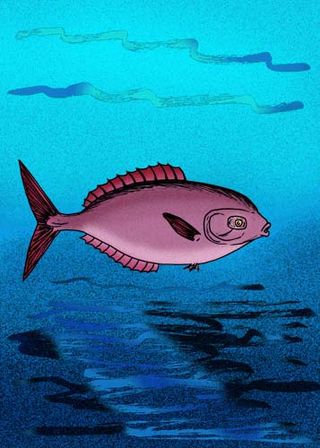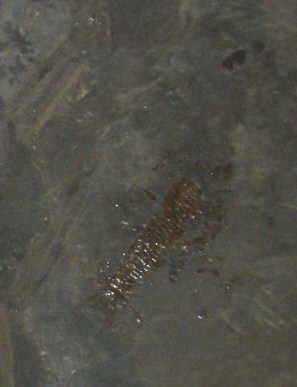
Beerichthys is an extinct genus of prehistoric marine ray-finned fish. It contains a single species, Beerichthys ingens, that was a member of the Ypresian London Clay fauna of lower Eocene England.
Eothynnus salmonens is an extinct species of prehistoric jackfish that lived during the lower Eocene of what is now the Isle of Sheppey (as a part of the London Clay Lagerstatten. It is known exclusively from some preserved skulls.
Aulopopsis is an extinct genus of prehistoric marine ray-finned fish that lived during the lower Eocene. It is considered a relative of lizardfish in the order Aulopiformes, but its exact taxonomic placement is uncertain. Some authorities place it with the Aulopidae, while others place it with the Giganturoidae.
Argilloberyx is an extinct genus of prehistoric marine bony fish that lived during the lower Eocene. It contains one species, A. prestwichae, known from the London Clay Formation on the Isle of Sheppey, United Kingdom. It is considered a member of the family Berycidae.
Chanopsis is an extinct genus of prehistoric freshwater bonytongue relative that lived from the late Aptian to the Albian stage of the Early Cretaceous epoch. It contains a single species, C. lombardi from the Democratic Republic of the Congo.
Salminops is an extinct genus of prehistoric bony fish that lived during the Cenomanian known from USA and Portugal.
Aetheolepis is an extinct genus of ray-finned fish which lived in freshwater environments in what is now Western Australia and New South Wales during the Jurassic period. It contains one species, A. mirabilis. Aetheolepis was previously thought to be an archaeomaenid, until a 2016 study instead recovered it as a member of the family Dapediidae. Like other dapediids, it had a deep, discoid-shaped body. Fossils of A. mirabilis have been found in the Talbragar River fossil beds of New South Wales and the Colalura Sandstone of Western Australia. It was named by Arthur Smith Woodward in 1865 along with other Talbragar fish.
Agecephalichthys is an extinct genus of prehistoric freshwater "palaeonisciform" ray-finned fish that lived during the Anisian age. It contains a single species, A. granulatus from the Hawkesbury Sandstone in what is now New South Wales, Australia.
Elpistoichthys is an extinct genus of prehistoric marine ray-finned fish, likely a teleosteomorph, that lived in Europe during the early Carnian stage of the Late Triassic epoch. It is known from the Reingrabener Schiefer formation of Austria.

Habroichthys is an extinct genus of prehistoric bony fish that lived during the early Ladinian stage of the Middle Triassic epoch, 242 to 232 million years ago. It has been found in Austria, China, Italy, Slovenia, and Switzerland. It was a small fish measuring 26 cm (10 in) long.
Cephaloxenus is an extinct genus of prehistoric marine ray-finned fish that lived during the early Ladinian stage of the Middle Triassic epoch.
Eugnathides is an extinct genus of prehistoric bony fish that lived from the Oxfordian to the early Tithonian stage of the Late Jurassic epoch. Eugnathides may have been similar to Sphaerodontes.
Bregmacerina is an extinct genus of prehistoric marine ray-finned fish, most likely a codlet, that lived during the early part of the Miocene epoch. It contains a single species, B. antiqua, from the Burdigalian Sakaraul Horizon Formation of North Caucasus, Russia.

Ctenothrissa is a prehistoric genus of marine ray-finned fish in the order Ctenothrissiformes. It contains a number of species known from the Late Cretaceous of England and Lebanon.
Eocoelopoma is an extinct genus of prehistoric scombrid fish, related to mackerels and tunas, known from the Eocene of Eurasia. It contains several species known from the Early Eocene of England and Turkmenistan.
Kentuckia is an extinct genus of prehistoric bony fish.
Korutichthys is an extinct genus of prehistoric marine bony fish that lived during the Lopingian epoch in what is now Krasnoyarsk Krai, Russia. It was first referred to the family Amblypteridae, a view that was later questioned.
Naxilepis is an extinct genus of prehistoric bony fish.

Notagogus is an extinct genus of prehistoric bony fish. They can be found in the Solnhofen Plattenkalk.

Orthocormus is an extinct genus of prehistoric pachycormiform bony fish. It is known from three species found in Late Jurassic (Kimmeridgian) aged plattenkalk deposits in Bavaria, Germany. The species "Hypsocormus" tenuirostris Woodward 1889 from the late Middle Jurassic (Callovian) Oxford Clay is not closely related to the type species of Hypsocormus, and is more closely related to Orthocormus + Protosphyraena, and thus has sometimes been referred to in open nomenclature as Orthocormus? tenuirostris. The species of Orthocormus reached over a metre in length, and are thought to have been pelagic predators.



